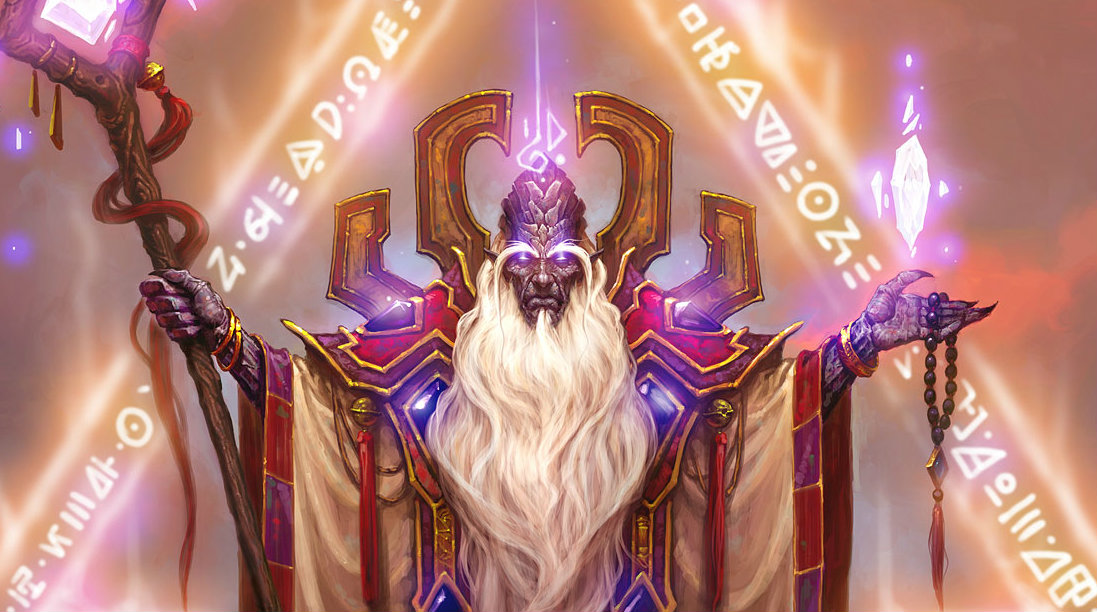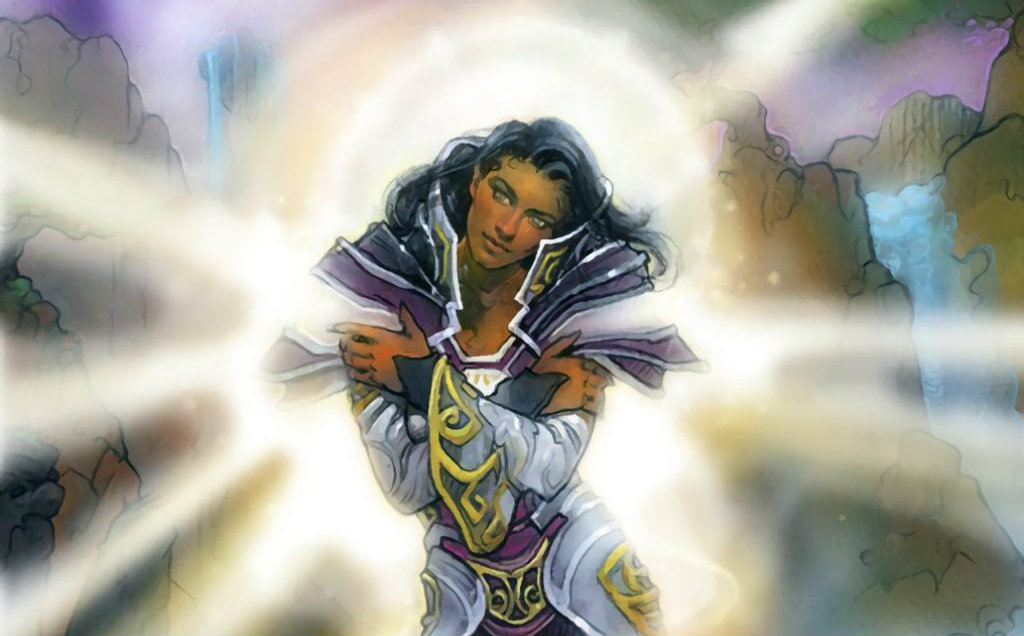Sottle on the state of Priest in Hearthstone
Just how bad is the worst class in the game, and what’s to be done about it?

Let’s start by being brutally honest. Priest is bad. Really, really, bad. Never before in Hearthstone’s history has the choice of weakest class in the game been so clearly defined. Things looked fairly rosey for Priest (as they often do, but more on that later) in the early days of Standard, with the Dragon Priest and N’Zoth Priest archetypes briefly dangling their toes into the pool of success. Quickly though, those toes were devoured by ravenous piranhas in the form of finely tuned tempo-based decks, and Priest hobbled back into mediocrity.
By now, it has reached the point of a joke. When streamers queue into Priests on ladder, the free win is a good laugh for everyone. “New class!” chat exclaims, and it’s easy to see why. A quick look at Vicious Syndicate’s latest Data Reaper report tells the story. If you’re not familiar with how Data Reaper works, it’s enough to know that all that red and orange next to the Priest entry… well, that’s not good. Outside of ladder, the class is pretty much a complete no-show in the competitive format. Perhaps the final nail in the coffin was when Insomnia Truesilver Champion, and Priest stalwart, Ness chose not to bring Priest as any part of his lineup to Dreamhack Valencia.
So what’s the problem? There are many, including how the class cards are balanced, the design of the hero power, and the overall philosophy of Hearthstone. But for now, let’s start with:
Priest can’t beat the field
This is the classic issue with Priest, and the one that keeps it from being a dominant ladder deck. This is a historical problem and not one that has particularly been exacerbated by Standard, but needs explaining none the less. Priest is primarily a reactive class, which means the majority of its cards require certain situations or actions from the opponent in order to become effective.
So the question becomes: Which situations do you try to react to? Shadow Word: Death and Shadow Word: Pain by nature target specific types of minions. Death is not going to get a great deal of work done against Zoo, while conversely you’d take all the Pains in the world against them. Entomb can help you to out-resource control decks in the late-game, but you’re also going to need Wild Pyromancer in order to contest the early flood of Aggro. Elise? Justicar? Flash Heal? Holy Champion? Blademasters? Shadow Word: Horror? Excavated Evil? All of these cards are powerful against specific decks, but absolutely terrible against others. It’s one thing to twiddle your thumbs waiting for your opponent to make the play that makes the cards in your hand useful, but quite another if that situation never appears because you queued into the other side of the meta.

THAT Hero Power
Oh Lesser Heal… Is there any more humiliating feeling in Hearthstone than the early-game interaction between Control Warrior and Control Priest. While Garrosh sits guffawing and climbing above the dizzy heights of 30 life, Anduin is stuck passing, or ruefully healing his own face because you just HAVE to bluff having those Frost Giants, right?
The simple fact is that the Priest hero power sucks if you do not have the board, and to compound matters, Priest has no tools to be able to take an early board consistently. In other decks, Lesser Heal is often a solid pickup from Sir Finley because it allows you to maintain the board advantage that strong tempo cards like Totem Golem give you. For Anduin, however, it’s borderline useless much of the time. If you manage to somehow, through a minor miracle, get a grip on the board then Lesser Heal is fantastic, but the game is usually decided long before that.
Keep up to date with the most important stories and the best deals, as picked by the PC Gamer team.

Tempo is king
Both of the previous points skirt around the real reason why Priest sucks right now. Hearthstone, at its core, is not designed for a class like Priest to be successful. Sure, in the early days of an expansion when people are experimenting with unrefined decks, you can have success with control or grinder-type builds. But as time goes on, the meta invariably becomes dominated by fast, refined, consistent tempo and aggro decks.
This happens time and time again and the pattern is clear. The decks that tend to break it are not pure control decks, but powerful combo decks like Freeze Mage, Miracle Rogue, and Patron Warrior, which then inevitability receive heavy-handed nerfs as Team 5 continue their quest to make Hearthstone combat happen entirely between minions on the board and removal spells.
So what’s the problem with that and why does it damage Priest? Well firstly, spells are bad. Sorry, they just are. How many removal spells in Hearthstone can actually take care of a minion and simultaneously allow you to improve your board position on the same turn? Sap can do it, Hex can have a good stab at it, and sometimes Fireball will get the job done. But, on the whole, clearing the board using a spell instead of a minion means passing the initiative back to your opponent to refill with another threat. There’s no point having all the answers if your opponent is never going to run out of questions.

Rest in piece, sweet, explosive princes.
At the root of this is the fact that taking the initiative in Hearthstone—whether you want to call it tempo, or being the one asking the questions—is way too powerful. Unlike other card games, the attacker in Hearthstone controls 100% of the play, so the person who is ahead on the board is the one who dictates the pace of the entire game. They can choose to demand specific responses from an opponent, or hold back and allow the status quo to continue.
It’s this dynamic that makes cards like Excavated Evil, or even Lightbomb—a bygone hero of a forgotten age—ineffective. Sure, you can blow up three or four of your opponent’s minions, and that’s just lovely, but you’ve spent your whole turn doing it, allowing your opponent to jam a few more dudes back on the board and put you back in the same spot.
Given that dynamic, finding the best decks becomes, in theory, pretty straightforward. If the game is heavily tilted towards minion combat, then the heroes with access to the best class minions, decks which can curve out and play a powerful creatures on turns 1, 2, and 3, are going to be overwhelmingly favoured against those that can’t.

Take a look at the current meta and pick the four best classes. Ok, we’ve unanimously come up with Warrior, Warlock, Shaman and Druid. Let’s evaluate why that is. Druid is the outlier—one of the aforementioned combo decks that can hang with the big boys, partly thanks to its hardy perennials Innervate and Wild Growth allowing it to cheat out big creatures early. But what links Warlock, Shaman, and Warrior? Possessed Villager, Dark Peddler, Imp Gang Boss, Darkshire Councilman, Tunnel Trogg, Totem Golem, Tuskarr Totemic, Flamewreathed Faceless, Alexstrasza’s Champion, Frothing Berserker, Ravaging Ghoul… These are all classes that can curve out perfectly.
If they play a dude on each of the opening turns, then they’re probably winning. It’s really that simple. The decks in question have also been highly optimised over time, with their curve being refined to an exact science to ensure the greatest possible consistency.
That sounds bad! How do we fix it?
It’s not easy. Short of fundamentally changing the design ethos of Hearthstone, you’re looking at a bunch of halfway house fixes that only really plug the gaps. The problem is also somewhat specific to Priest. Control decks are viable, don’t get me wrong, but the other classes have much better tools to make that plan happen. Warrior can stack up life total numbers higher than the average Dragon Warrior player can count, giving them near infinite time to stabilise. Warlock can make fantastic use of Reno Jackson in a way that other classes can’t, due to being able to draw the card much more consistently through Life Tap. Mage has Ice Block, etc.
Blizzard could opt to print more tempo based removal cards for Priest. Things that occupy the board at the same time as answering threats from the opponent. (Think cards like Imp-losion or Blood to Ichor.) This would then allow them to start using their Hero Power, Northshire Cleric, and buffs like Power Word: Shield to build an advantage. The problem with this plan is two-fold though: Firstly, high tempo removal is incredibly powerful and used extremely sparingly in Hearthstone, so adding a bunch to Priest might push the class too far in the other direction. The second issue is that any cards you introduce, no matter how powerful, will only last as long as they remain in Standard format. Once they rotate out, Priest is back to square one. Sucking.
How can you compete with a deck that can curve and infinitely regenerate minions?
Alternatively, Blizzard could print a big old pile of initiative-grabbing minions so Priest can play on the board like the rest of big boys. This is the boring solution. This homogenises Priest with the rest of the classes and makes the game more bland, but it would work (again, until those cards rotated out). Just for heaven’s sake, start with a 2-drop. Even this has dangers though. If you give a class with the Priest hero power the ability to occupy the board early, then you turn arguably the worst Hero Power in the game into the best one, and the whole problem reverses. How can you compete with a deck that can curve out with the best of them, AND infinitely regenerate their minions?

Finally, here’s the solution I like. Take Priest back to its pre-Standard power level. Check out Wild to see what I mean. Okay, actually don’t, it’s not good for your long term health or sanity, just take my word for it—Priest is great! If Blizzard could introduce relatively similar equivalents to cards like Deathlord (cheap, high health Taunt with a drawback), Lightbomb (large AoE), and Sludge Belcher (mid-game sticky board presence), but make those cards exclusive to Priest, then maybe the class can climb back onto its platform of being the ultimate ladder annoyance. Steal your stuff, kill what’s left, and lock you out of the game.
That might not sound fun to some of you, but believe me, there are plenty of sick twisted individuals like myself who would rather play 100 games of Fatigue Priest than be subjected to one more match of Dragon Warrior.


